Best AI Tool to Summarize YouTube Videos: Watch Smarter, Not Longer

The AI Revolution in Video Summarization
In 2025, YouTube isn’t just a video platform—it’s the world’s largest knowledge library. From two-hour university lectures to detailed product breakdowns and podcast interviews, it’s where people learn, research, and grow. But there’s one challenge that continues to frustrate even the most dedicated learners: time.
The explosion of long-form video content has created a paradox. We’ve never had more access to valuable information, yet most of us don’t have the time to consume it all. Watching hours of footage for a few key takeaways simply isn’t efficient—especially for researchers, students, and marketers juggling multiple priorities.
That’s where the AI revolution in video summarization comes in. The emergence of AI-powered video content summarizers has changed how we process information. These tools can condense hours of content into a structured summary or even bullet points in seconds. They extract the essence—core ideas, timestamps, and even speaker insights—without requiring you to sit through the entire video.
For creators, educators, and businesses, this automation means reclaiming time while maintaining depth and accuracy. The real art lies in finding the best AI tool to summarize YouTube videos—one that balances accuracy, context, and creativity. The goal isn’t just to shorten the content; it’s to make comprehension effortless.
In my own testing, the most effective AI YouTube video summarizer online solutions go beyond simple text extraction. They leverage natural language processing (NLP), semantic clustering, and multimodal learning to recognize not only what is said—but how it’s said. This isn’t just efficiency; it’s evolution.
Why AI Video Summarization Tools Are Game-Changers
The Rise of YouTube Learning & Information Overload
YouTube has evolved into the default classroom of the modern world. Users consume over a billion hours of video daily, yet only a small fraction of that content gets fully absorbed. The challenge isn’t access—it’s attention.
AI summarization tools are becoming essential for digital learners. Imagine condensing an entire two-hour lecture into a five-minute reading summary. That’s exactly what students are achieving today with tools like Syllaby and Recall, which streamline university lectures into crisp, digestible notes.
The ability to summarize long YouTube videos instantly is more than a convenience—it’s a productivity multiplier. In a world overflowing with tutorials, discussions, and explainer content, these tools help learners and professionals filter noise from value.
Who Benefits from AI Video Summarizers
AI video summarizers serve a wide audience. For content marketers, these tools repurpose hours of webinars into blog posts, tweets, and newsletters. For students, they transform lessons into instant study notes. For journalists and researchers, they extract reliable insights and save countless hours of transcription.
Modern AI note-taking tools for YouTube learning now include multi-video libraries and topic clustering. For creators and educators, they make revisiting old content seamless, ensuring every video continues to serve value long after it’s published.
Why Manual Summaries Fall Short
Manual summarization is subjective and time-intensive. People often lose context, omit nuance, or misinterpret speaker tone. AI fixes that. It uses NLP and semantic analysis to extract meaning rather than just words—understanding how themes connect across a video’s timeline.
What impressed me in testing models like Gemini and Recall was their ability to detect contextual shifts in conversation. When a speaker transitions from “theory” to “application,” the AI recognizes that pivot and structures the summary accordingly. These tools don’t just hear; they interpret.
That’s the future—one where AI-powered video content summarizers help us stay informed without burning out.
How AI Tools Summarize YouTube Videos
Transcript Extraction and Natural Language Understanding
Every great summary begins with a great transcript. When you paste a YouTube link into a summarizer like NoteGPT, the AI first retrieves closed captions or generates its own transcript using automatic speech recognition (ASR). It then applies natural language processing (NLP) to detect topics, intent, and hierarchy.
From my experience, tools like NoteGPT go a step further—they refine rough transcripts using contextual prediction to ensure speaker flow is preserved. This accuracy is critical because small errors in transcription can distort meaning. Once the transcript is stable, the system runs sentiment analysis and keyphrase detection to highlight themes, names, and timestamps.
That’s why AI transcription and summarization software like NoteGPT and Otio have become foundational to modern research workflows. They allow professionals to transform long-form discussion into shareable, referenceable text effortlessly.
Summarization Models Explained (Abstractive vs Extractive)
There are two types of summarization models at play today: extractive and abstractive. Extractive models pull direct sentences or phrases from the transcript—great for fast factual overviews. Abstractive models, on the other hand, rewrite content in their own words, using large language models (LLMs) like GPT-4 and Gemini to produce fluent, human-like text.
In Microsoft Copilot’s ecosystem, for example, abstractive summarization allows users to not just view a summary, but to ask questions about it in real time. This interactivity turns passive video watching into active learning.
The best AI tool to summarize YouTube videos typically blends both approaches—preserving factual integrity while improving readability.
Context Retention and Multimodal Learning
Modern summarization tools don’t stop at text—they consider visuals and tone too. This is called multimodal learning. Tools like Otio and Recall analyze the visual frames, speaker emphasis, and even slide text to ensure that the summary reflects what was shown, not just what was said.
This technology is a leap forward for professionals using YouTube as a learning platform. For instance, Recall’s AI video insight extractor for research mode can highlight when a new graph appears, or when a topic visually changes direction. It’s context retention on a deeper, more human level.
Criteria for Choosing the Best AI Tool to Summarize YouTube Videos
Accuracy & Context Awareness
Accuracy is everything. The ideal tool should preserve tone, capture transitions, and avoid over-simplifying technical material. In my testing, Recall excelled at mapping conversation topics and visual markers across video segments, maintaining flow from introduction to conclusion.
The best AI summarizers now understand why a point matters, not just what was said. That’s why users need an AI-powered video content summarizer that balances brevity with comprehension.
Speed and Automation
Time is the currency of modern content creation. Tools like VidIQ and Gemini demonstrate how automation and speed coexist. With one click, they can extract, summarize, and generate insights—often faster than real-time playback.
Of course, speed comes with trade-offs. Some faster models might lose nuance in technical content. But when latency is low and context preservation is high, creators can stay agile without losing accuracy.
Customization & User Control
Personalization is the differentiator. Not everyone wants a paragraph-style summary; some prefer outlines, bullet points, or mind maps. Tools like MyMap now offer structured visualizations that help users grasp topic relationships instantly.
The smart AI apps to condense video content allow prompts like “summarize for students” or “summarize for marketers,” adapting tone and depth automatically. That’s intelligent flexibility—AI that understands intent.
Accessibility & Pricing
Finally, accessibility determines scalability. Free options like Syllaby Summarizer and NoteGPT are great for casual learners, offering quick overviews without sign-ups. Freemium platforms like Otio and Recall give professionals more power—custom export options, search history, and shared libraries.
Premium tiers, used by research teams and content creators, unlock deeper analytics and multi-video dashboards. For most users, though, a free AI video summarization app is the perfect starting point to test what works best for their workflow.
The Best AI Tools to Summarize YouTube Videos in 2025
As someone who tests dozens of AI tools every month, I can say confidently that AI video summarization has reached a pivotal point in 2025.
The market has matured: tools are no longer just “helpful assistants” — they’ve become indispensable cognitive extensions for creators, researchers, and learners.
Below, I’ve broken down the best AI tools to summarize YouTube videos, highlighting what each does best — from research-grade summarization to one-click automation.
1. Recall – Best for Researchers and Power Users
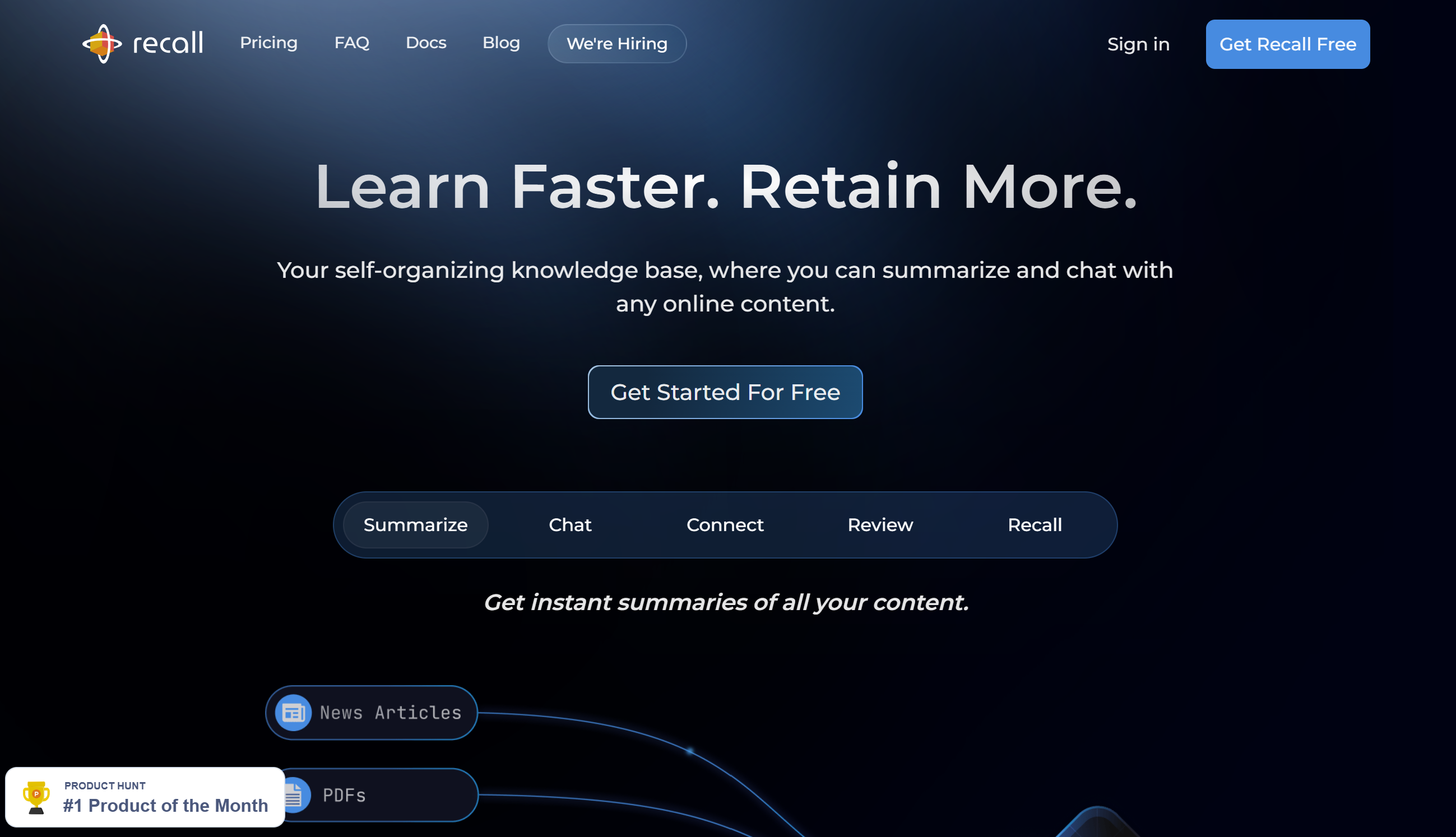
If you’re serious about productivity, Recall is in a league of its own. It’s built for users who manage massive knowledge libraries — researchers, academics, and professionals who need depth without losing detail.
What makes Recall stand out is its contextual mapping. Instead of generating generic bullet points, it identifies conceptual anchors across videos, linking related themes through semantic clustering. In practice, that means if you watch three videos about “neural networks,” Recall can connect their overlapping concepts and give you a unified summary.
From a workflow standpoint, it’s seamless. You paste a YouTube link, and within seconds, Recall creates structured notes complete with timestamps, tags, and even flashcard-ready points. In my own testing, it was impressively accurate at summarizing multi-speaker discussions and long-form tutorials.
Pros:
- Context-rich summaries ideal for academic or professional use
- Library system with search, history, and tagging
- Flashcard mode for learning retention
Cons:
- Requires subscription for advanced features
- Best optimized for desktop rather than mobile
Best for: Researchers, data analysts, and students working with large volumes of educational content.
2. Syllaby YouTube Summarizer – Best Free Chrome Extension
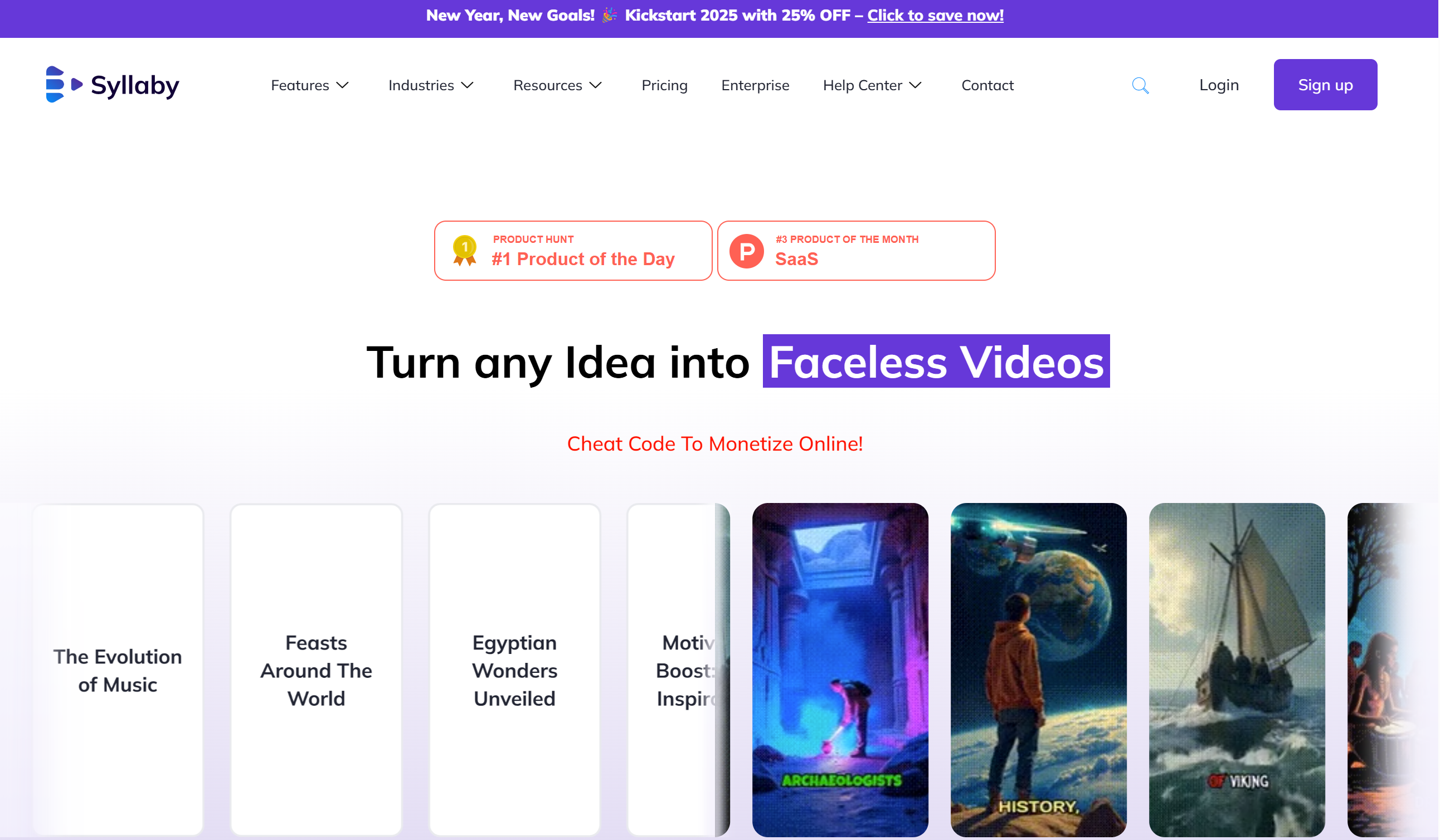
For users who value speed and simplicity, Syllaby Summarizer is the go-to choice. It’s a lightweight browser extension that works directly inside YouTube — no extra windows or account setup needed.
Click once, and Syllaby instantly extracts key insights, highlights, and timestamps. It’s designed for students who want to summarize long YouTube videos instantly, like lectures or explainer videos, without jumping between multiple tools.
Its summaries aren’t overly technical but are concise and readable. I especially liked how it automatically identifies the video’s key sections, making navigation much faster.
Pros:
- 100% free with no sign-up
- Fast, simple summaries with timestamps
- Perfect for quick academic use
Cons:
- Limited formatting and export options
- Less context retention in nuanced content
Best for: Students, educators, and casual users who want fast summaries without extra complexity.
3. VidIQ AI Coach – Best for Creators and SEO Professionals
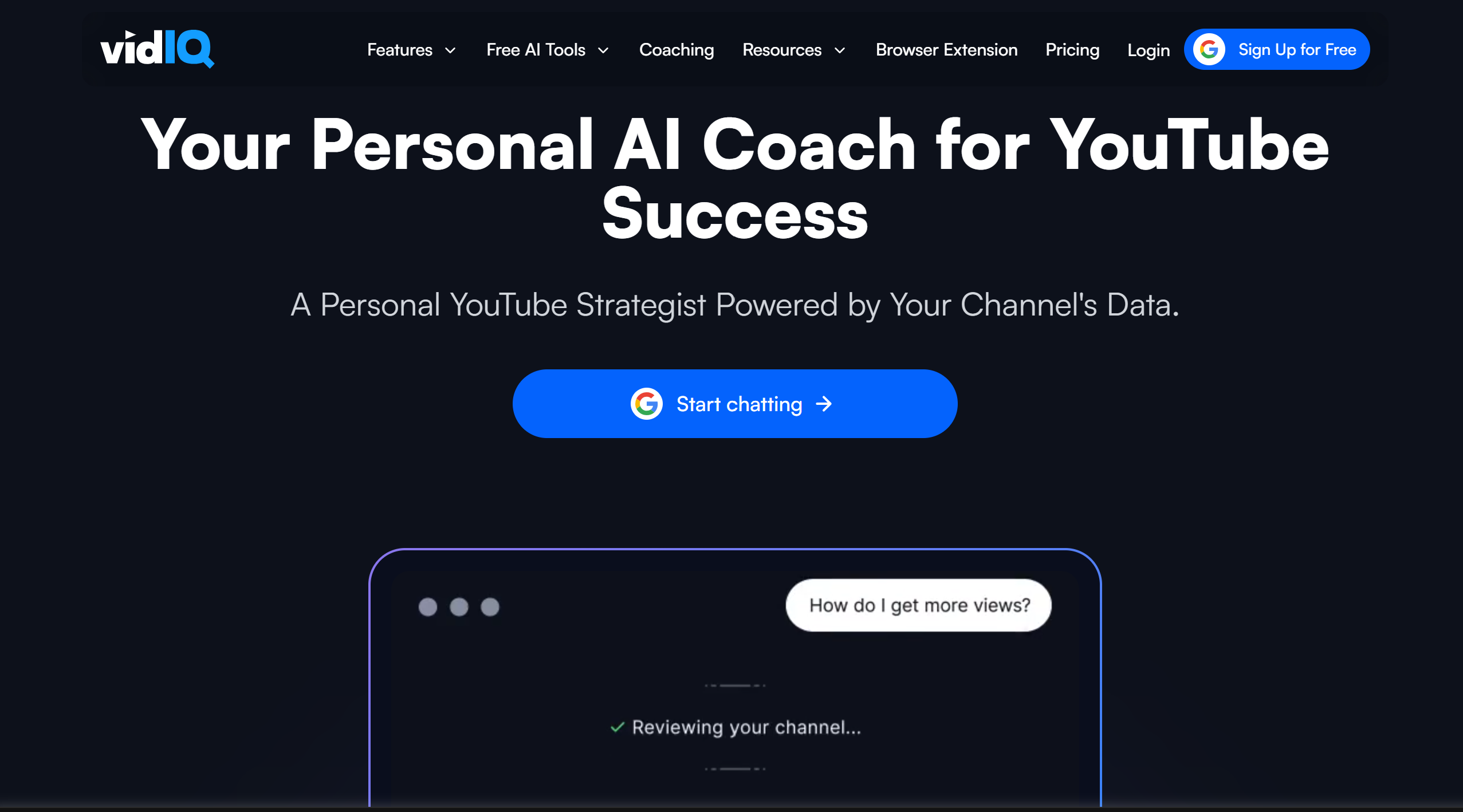
VidIQ is already a household name among YouTubers, but in 2025, its AI Coach feature has taken things to another level.
Beyond just analytics, VidIQ now includes an AI-powered video content summarizer and contextual question-answering feature. It’s designed for creators who want to repurpose their videos — turning 10-minute explainers into Twitter threads, captions, or blog outlines.
Its AI Coach summarizes video content, extracts metadata for SEO, and can even suggest trending keywords or hashtags based on the topic.
Pros:
- Integrated directly within the YouTube workflow
- SEO-driven summaries for content repurposing
- Great Q&A interface for creators
Cons:
- Some features require a premium plan
- Summaries focus more on structure than narrative nuance
Best for: YouTube creators, marketers, and brand strategists optimizing video visibility and engagement.
4. Otio – Best for Workflow Integration and Multi-Video Management
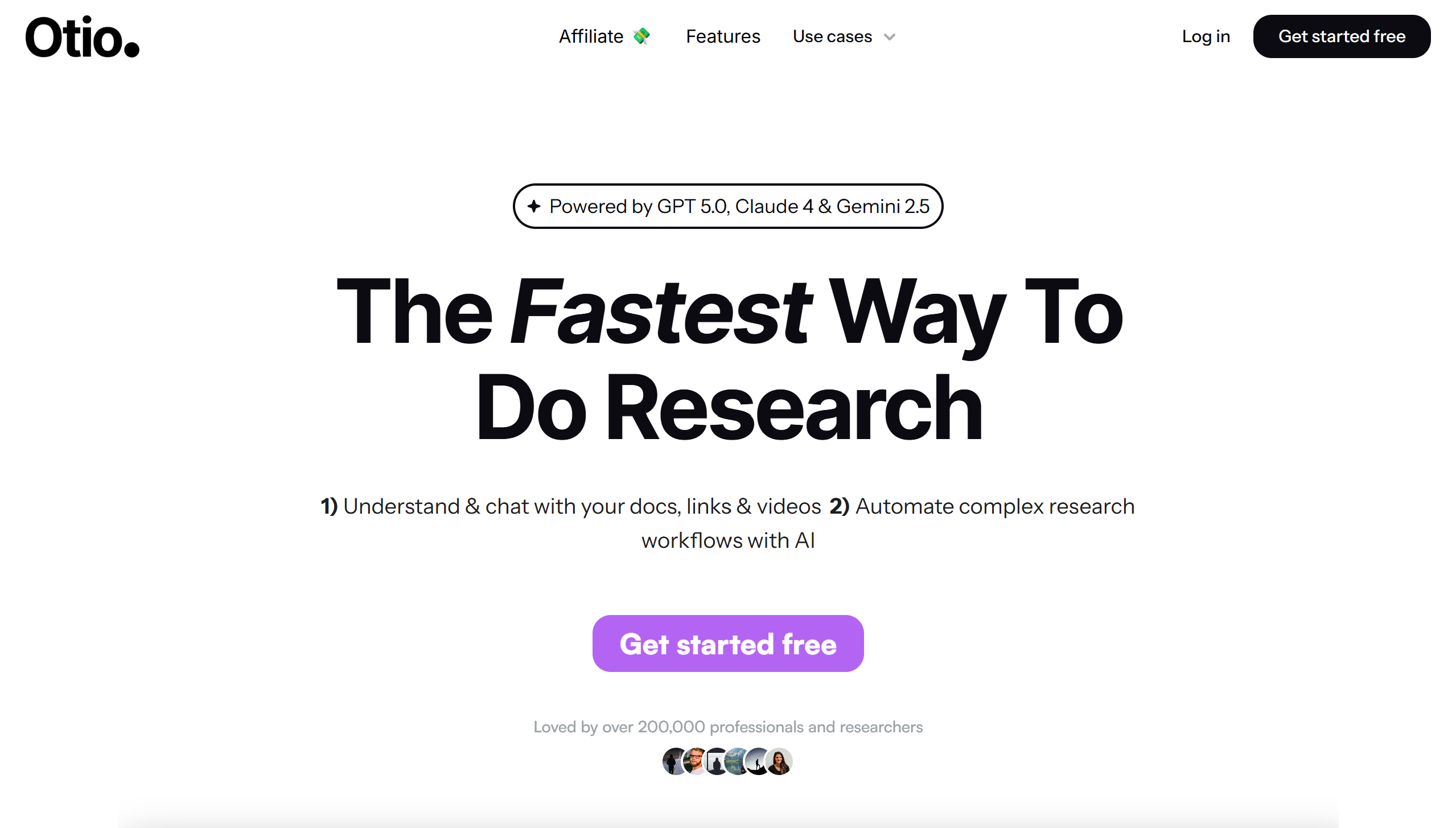
Otio is for users who live and breathe research or creative workflows. It doesn’t just summarize — it organizes.
When I tested it, I immediately noticed how Otio integrates with note-taking systems and collaboration platforms like Notion and Obsidian. You can summarize multiple videos and manage all outputs in one central dashboard.
Its AI doesn’t just extract data — it recognizes thematic continuity across videos. So, if you’re analyzing a multi-part lecture or a video series, Otio keeps the context intact. The experience is akin to having an AI research assistant catalog your YouTube history for you.
Pros:
- Excellent UI and workflow organization
- Multi-video library with export options (Markdown, Notion, Docs)
- Context-retentive summaries for long-form content
Cons:
- Limited free access
- Requires setup for integrations
Best for: Researchers, analysts, and creators who rely on structured, repeatable workflows.
5. Gemini (Google) – Best for Speed and Native Integration
.png)
Google’s Gemini AI integration into YouTube has quietly changed the game. For users who value speed and reliability, this is easily one of the best AI tools to summarize YouTube videos available today.
When you’re watching a video, you can simply ask Gemini to summarize it in real time — no extensions or external links. The system reads the captions, analyzes the visuals, and instantly returns a summary, complete with relevant links and related topic insights.
It’s incredibly efficient for anyone using Google’s ecosystem (Docs, Drive, Gmail). The context-carrying capability means you can continue research seamlessly across apps.
Pros:
- Instant summarization inside YouTube
- Seamless integration across Google tools
- Excellent for short-form content and quick overviews
Cons:
- Basic formatting
- Still improving context depth for longer videos
Best for: Professionals, students, and everyday users who want built-in convenience.
6. MyMap – Best for Visual and Conceptual Learners
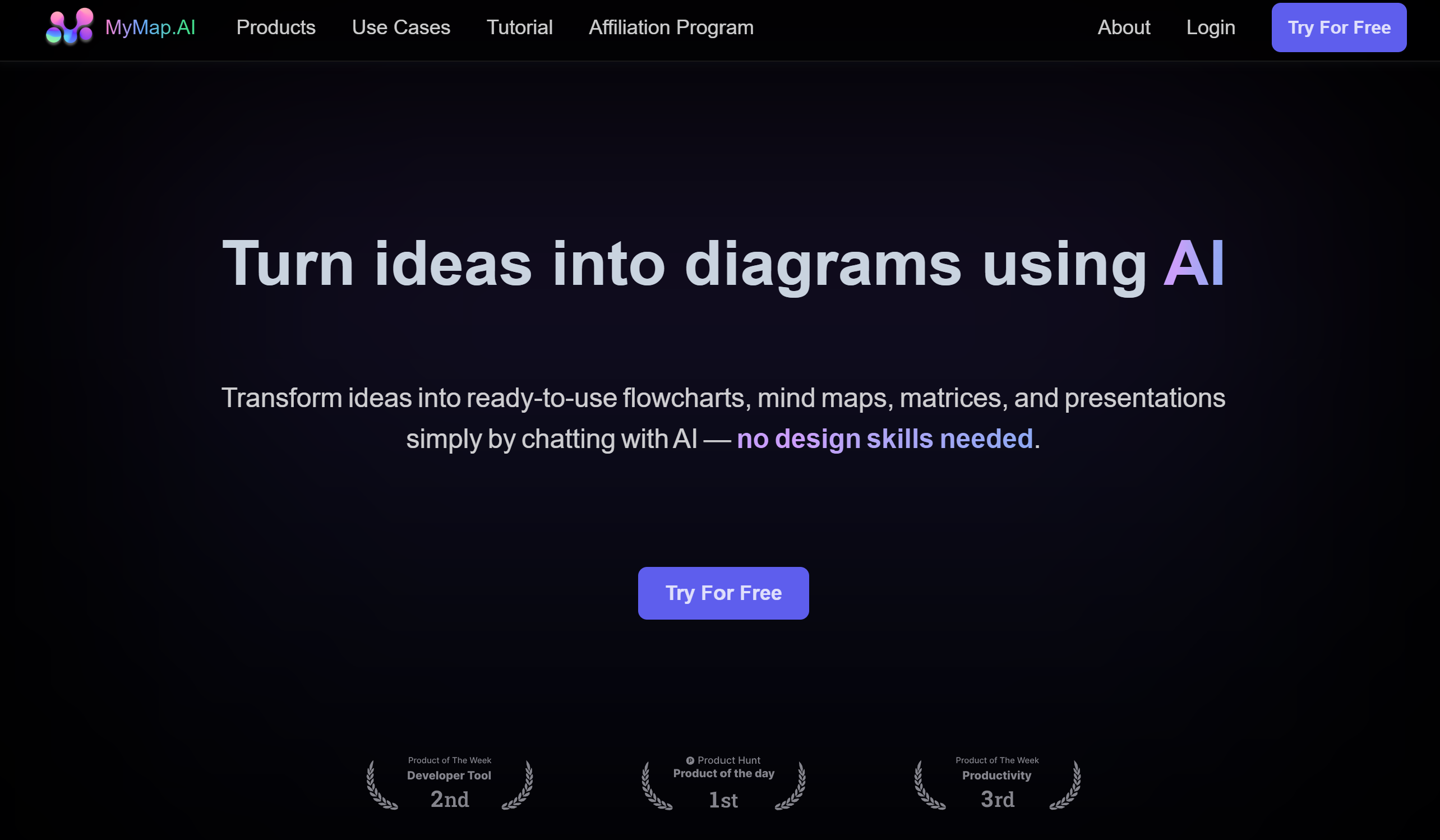
If you’re a visual thinker, MyMap will feel like home. Unlike traditional text summarizers, it turns YouTube content into interactive mind maps.
Paste a link, and MyMap creates a web of related ideas, timestamps, and visuals. You can click on any node to expand or view the underlying context. It’s not just about what’s said; it’s about how topics connect.
This makes it perfect for brainstorming sessions, strategy work, or studying complex theories where visual association enhances memory retention.
Pros:
- Converts summaries into mind maps
- Intuitive visual learning format
- Great for collaboration and concept linking
Cons:
- Slight learning curve
- Not ideal for text-heavy academic summaries
Best for: Visual learners, strategists, and teams working on creative planning or conceptual work.
7. NoteGPT – Best for Multilingual and Global Users
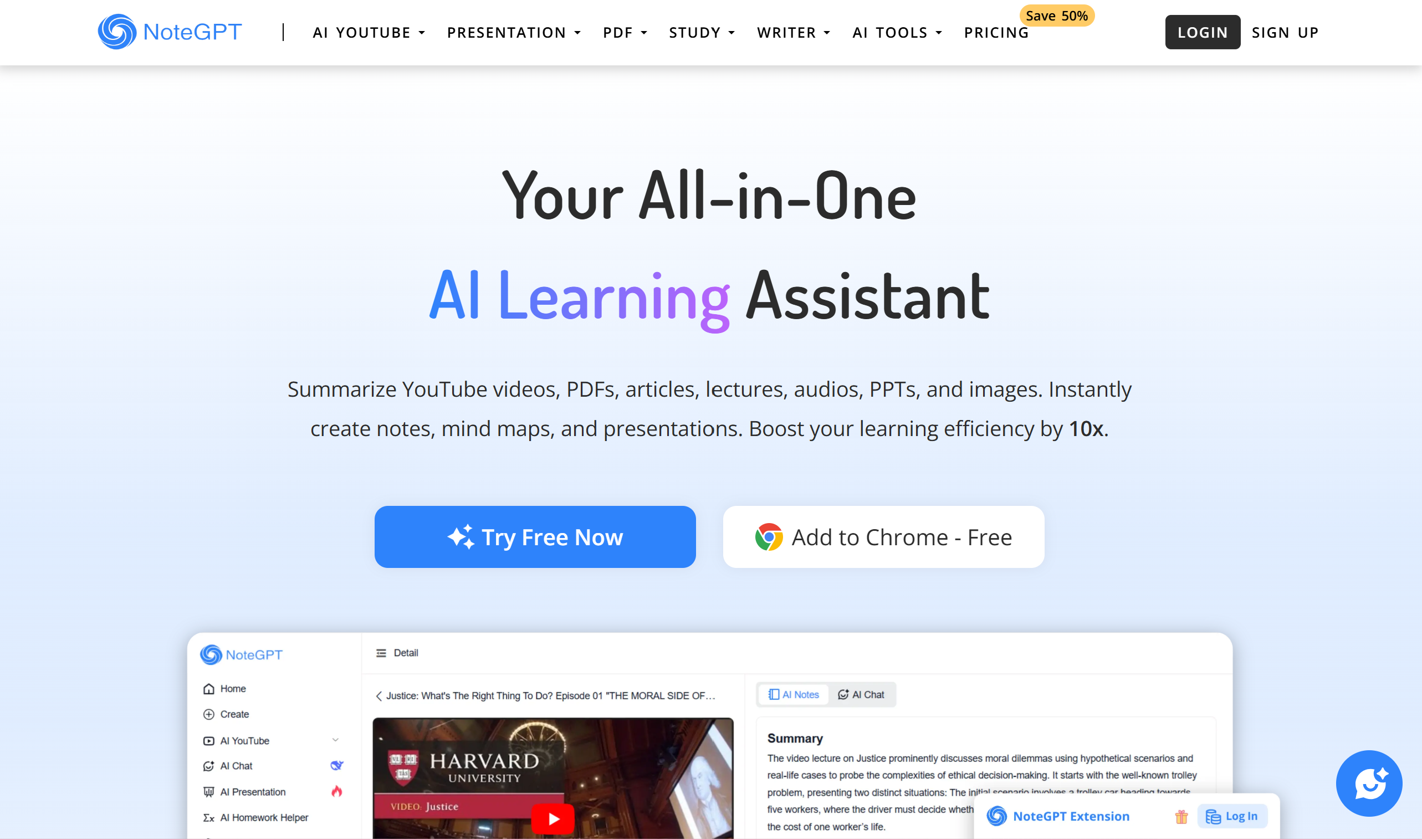
NoteGPT has gained popularity because of its ability to process and summarize YouTube videos in multiple languages. Whether it’s an English lecture, a Spanish tutorial, or a Japanese interview, NoteGPT can transcribe and summarize with impressive accuracy.
It uses AI transcription and summarization software backed by multilingual NLP models, making it perfect for users studying international content.
I found it particularly effective for videos with multiple speakers or accents — its speech-to-text engine was consistent, and its summaries were clean, logical, and language-appropriate.
Pros:
- Supports multiple languages
- Accurate transcription and contextual summarization
- Integrates with Google Drive and Notion
Cons:
- Limited free tier (15 summaries/month)
- Occasional lag with long-form videos
Best for: Students, researchers, and global learners working across multilingual video content.
8. Readwise Reader – Best for Knowledge Management
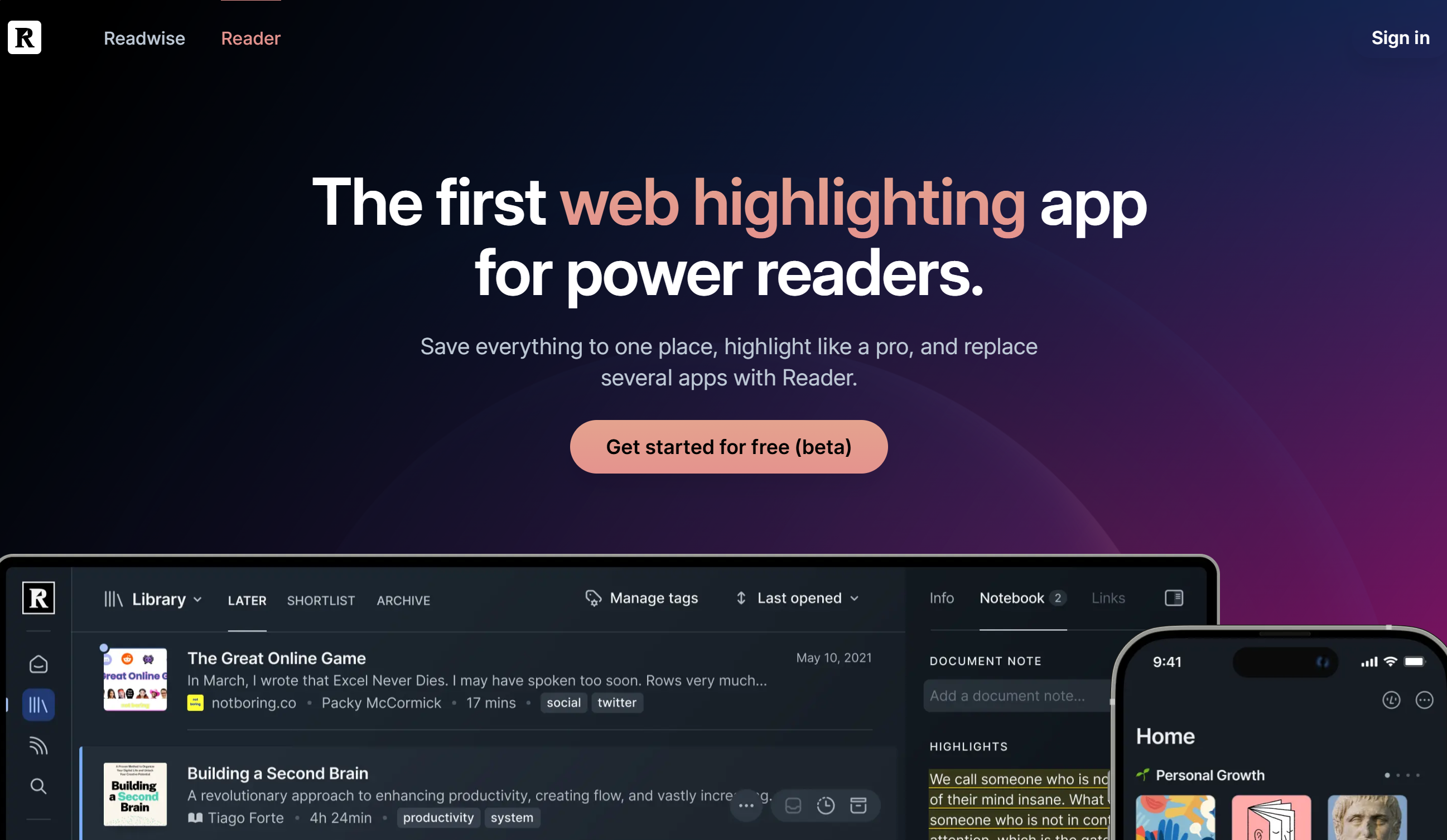
Readwise Reader isn’t just a summarizer — it’s a full-on knowledge hub. Designed for people who read and watch constantly, it allows you to collect, tag, and highlight key moments from YouTube videos, podcasts, and articles.
What makes it stand out is its integration with knowledge management tools like Notion, Roam, and Obsidian. It’s perfect for those building long-term information systems or “second brains.”
Pros:
- Multi-source summarization (video, audio, text)
- Deep integration with note-taking tools
- Ideal for long-term research workflows
Cons:
- Best suited for experienced users
- Minimal visual summaries
Best for: Researchers, writers, and lifelong learners managing high-volume information ecosystems.
Ethical & Practical Use Cases for AI Video Summarization
AI summarization tools are reshaping how people learn, research, and produce content — but they also come with ethical considerations. As someone deeply immersed in AI product strategy, I believe the conversation isn’t just about capability, but responsibility.
Academic and Research Integrity
AI has made it possible to summarize educational videos with AI in seconds, turning hours of lectures into concise study notes. However, this convenience comes with responsibility. Students must ensure that summaries are used as learning aids, not as shortcuts to avoid engagement.
Universities are beginning to recognize AI summarization tools as acceptable study assistants, provided the content is cited and paraphrased properly. The key is to treat these summaries like research notes — helpful for comprehension, but not substitutes for critical thought.
For researchers, tools like Recall and NoteGPT can accelerate literature reviews by summarizing interviews, webinars, and recorded conferences. But as a professional, I always recommend maintaining a human layer of interpretation. AI can capture “what” was said — only humans understand why it matters.
Productivity and Content Repurposing
One of the most powerful applications of these tools lies in AI-powered tools for content repurposing.
Marketers, podcasters, and educators are leveraging AI to turn long-form YouTube videos into multiple micro-content assets — captions, carousels, tweets, and blog posts.
For example, creators using VidIQ and Otio can summarize an hour-long webinar, identify the five most engaging points, and repurpose them into social-ready snippets. This isn’t just time-saving — it’s a full creative workflow optimization.
Similarly, journalists now use AI video insight extractors for research to pull soundbites, statistics, and context from long discussions. The output isn’t a replacement for editorial judgment; it’s the foundation for faster storytelling.
Accessibility and Learning Inclusion
Accessibility is one of the most overlooked yet transformative aspects of AI summarization.
For neurodiverse individuals or non-native English speakers, tools like NoteGPT and Syllaby Summarizer break language barriers and cognitive load.
A free AI video summarization app doesn’t just summarize — it democratizes access to learning. Someone who couldn’t follow a 90-minute tutorial due to speed or complexity can now grasp its key ideas in minutes, even across languages.
This inclusive impact is perhaps the most human outcome of AI — making global knowledge universally accessible.
The Future of AI Video Summarization
The evolution of video summarization isn’t slowing down — it’s accelerating. 2025 marks a turning point where the technology is no longer just functional; it’s intelligent, adaptive, and personalized.
Integration with Search and Knowledge Engines
Within the next 12 months, we’ll see AI YouTube video summarizers online integrate directly into search systems.
Google’s Gemini and Microsoft Copilot are already experimenting with contextual video search — where users won’t just “watch” a video but converse with its content.
Imagine asking: “Summarize the main argument of this TED Talk” — and receiving a visual mind map, timestamps, and direct follow-up answers. That’s where tools like Gemini and Recall are heading.
This integration will redefine how we consume media, turning passive watching into interactive learning.
Personalized Summaries and Learning Styles
The next frontier of smart AI apps to condense video content is personalization. Future tools will adjust summaries based on user intent — academic, creative, or professional.
For instance:
- A student might get an outline with definitions and examples.
- A marketer might get emotional hooks and campaign takeaways.
- A developer might receive technical steps and references.
AI systems are evolving to understand why a summary is being created — not just what needs summarizing.
Soon, these platforms will merge with personal productivity systems like Notion AI or Readwise, automatically organizing summaries into daily learning libraries.
The Human-AI Collaboration Model
As AI tools become smarter, human oversight becomes even more crucial.
The best AI tool to summarize YouTube videos is one that supports human creativity — not replaces it.
The future of summarization lies in collaboration. Humans will continue to define goals, context, and narrative, while AI handles speed, structure, and accuracy.
From my own experience using these tools across workflows, I see AI as an augmentation layer — a partner that amplifies focus and clarity, allowing us to do more meaningful work.
That’s the beauty of this evolution: it’s not about outsourcing thinking, but enhancing understanding.
Conclusion: The Smarter Way to Watch, Learn, and Grow
In a world overflowing with digital content, efficiency is no longer optional — it’s essential.
Choosing the best AI tool to summarize YouTube videos isn’t just about convenience; it’s about empowering how we learn, research, and create.
Tools like Recall, Syllaby Summarizer, and Otio are leading the charge — each redefining how we process video-based knowledge in unique ways. Whether you’re a student racing against deadlines, a marketer scaling content, or a lifelong learner exploring new fields, these tools make it possible to keep up without burning out.
AI doesn’t replace curiosity — it accelerates it.
And as someone who’s built and tested AI platforms, I can confidently say: the future of video learning isn’t passive watching — it’s active understanding, powered by intelligent tools that make knowledge instant, accessible, and personal.
